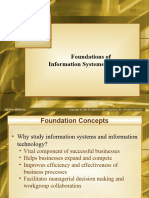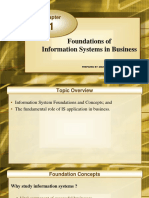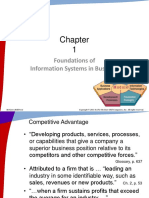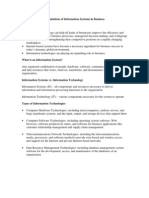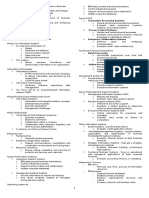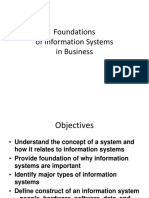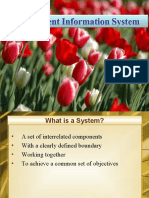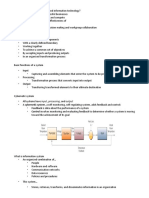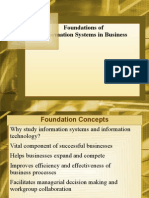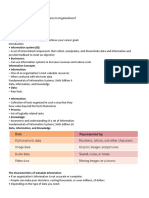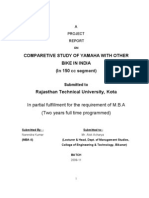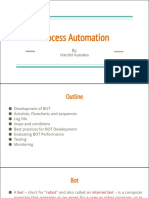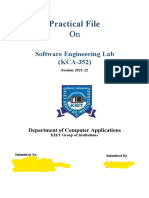Foundations of Information Systems in Business
Foundation Concepts
Why study information systems and information technology?
Vital component of successful businesses Helps businesses expand and compete Improves efficiency and effectiveness of business processes Facilitates managerial decision making and workgroup collaboration
1-2
�What is a System?
A system is
A set of interrelated components With a clearly defined boundary
Working together
To achieve a common set of objectives By accepting inputs and producing outputs In an organized transformation process
�Basic Functions of a System
Input
Capturing and assembling elements that enter the system to be processed
Processing
Transformation process that converts input into output
Output
Transferring transformed elements to their ultimate destination
�Cybernetic System
All systems have input, processing, and output A cybernetic system, a self-monitoring, selfregulating system, adds feedback and control:
Feedback is data about the performance of a system Control involves monitoring and evaluating feedback to determine whether a system is moving toward the achievement of its goal
�A Cybernetic System
�A Business as a System
�Other System Characteristics
If a system is one of the components of a larger system, it is a subsystem
The larger system is an environment
Several systems may share the same environment
Some may be connected via a shared boundary, or interface
�Components of an IS
1-9
�Information System Resources
People Resources
Specialists End users
Hardware Resources
Machines Media
Software Resources
Programs Procedures
1-10
�Information System Resources
Data Resources
Product descriptions, customer records, employee files, inventory databases
Network Resources
Communications media, communications processors, network access and control software
Information Resources
Management reports and business documents using text and graphics displays, audio responses, and paper forms
1-11
�Data Versus Information
Data are raw facts about physical phenomena or business transactions Information is data that has been converted into meaningful and useful context for end users Examples:
Sales data is names, quantities, and dollar amounts Sales information is amount of sales by product type, sales territory, or salesperson
1-12
�Types of Data
Table : Types of Data
�The Value of Information
Value of information is directly linked to how it helps decision makers achieve their organizations goals For example, value of information might be measured in:
Time required to make a decision Increased profits to company
�The Characteristics of Valuable Information
Table : Characteristics of Valuable Information
�The Characteristics of Valuable Information (continued)
Table : Characteristics of Valuable Information
�IS Activities
Input of data resources
Data entry activities
Processing of data into information
Calculations, comparisons, sorting, and so on
Output of information products
Messages, reports, forms, graphic images
Storage of data resources
Data elements and databases
Control of system performance
Monitoring and evaluating feedback
1-17
�What is an Information System?
An organized combination of
People Hardware and software Communication networks Data resources Policies and procedures
This system
Stores, retrieves, transforms, and disseminates information in an organization
1-18
�Information Technologies
Information Systems
All the components and resources necessary to deliver information and functions to the organization
Information Technologies
Hardware, software, networking, data management
1-19
�Fundamental Roles of IS in Business
1-20
�Trends in Information Systems
1-21
�Computer-Based Information Systems
Computer-based information system (CBIS)
A single set of hardware, software, databases, telecommunications, people, and procedures that are configured to collect, manipulate, store, and process data into information
�Computer-Based Information Systems (continued)
Figure : The Components of a Computer-Based Information System
�Purposes of Information Systems
1-24
�Types of Information Systems
Operations Support Systems
Efficiently process business transactions Control industrial processes Support communication and collaboration Update corporate databases
Management Support Systems
Provide information as reports and displays Give direct computer support to managers during decision-making
1-25
�Operations Support Systems
What do they do?
Efficiently process business transactions Control industrial processes Support communications and collaboration Update corporate databases
1-26
�Types of Operations Support Systems
Transaction Processing Systems
Record and process business transactions Examples: sales processing, inventory systems, accounting systems
Process Control Systems
Monitor and control physical processes Example: using sensors to monitor chemical processes in a petroleum refinery
Enterprise Collaboration Systems
Enhance team and workgroup communication Examples: email, video conferencing
1-27
�Transaction Processing Systems
Figure : A Payroll Transaction Processing System
�Two Ways to Process Transactions
Batch Processing
Accumulate transactions over time and process periodically Example: a bank processes all checks received in a batch at night
Online Processing
Process transactions immediately Example: a bank processes an ATM withdrawal immediately
1-29
�Management Support Systems
What do they do?
Provide information and support for effective decision making by managers
Management information systems Decision support systems Executive information systems
1-30
�Types of Management Support Systems
Management Information Systems (MIS)
Reports and displays Example: daily sales analysis reports
Decision Support Systems (DSS)
Interactive and ad hoc support Example: a what-if analysis to determine where to spend advertising dollars
Executive Information Systems (EIS)
Critical information for executives and managers Example: easy access to actions of competitors
1-31
�Management Information Systems
Management information system (MIS): an organized collection of people, procedures, software, databases, and devices that provides routine information to managers and decision makers Primary focus of an MIS is operational efficiency
�Management Information Systems
Figure : Management Information System
�Decision Support Systems
Decision support system (DSS): an organized collection of people, procedures, software, databases, and devices used to support problem-specific decision making Focus of a DSS is on decision-making effectiveness
�Decision Support Systems (continued)
Figure: Essential DSS Elements
�Expert Systems
Give computer the ability to make suggestions and act like an expert in a particular field Allow organizations to capture and use the wisdom of experts and specialists The knowledge base contains the collection of data, rules, procedures, and relationships that must be followed to achieve value or the proper outcome Expert advice, Example: Investment Advisor Applications
�Knowledge Management Systems
Knowledge management systems (KMSs): an organized collection of people, procedures, software, databases, and devices to create, store, share, and use the organizations knowledge and experience Support creation, organization, and dissemination of business knowledge throughout company Example: intranet access to best business practices
�Artificial Intelligence
Figure: The Major Elements of Artificial Intelligence
�IT Challenges and Opportunities
1-39
�Systems Development
Systems development: the activity of creating or modifying existing business systems A systems development project can be:
Done by people within the company Outsourced
To improve results of a systems development project, it is divided into several steps
�Systems Development
Figure : An Overview of Systems Development
�Developing IS Solutions
�Systems Investigation and Analysis
Systems investigation: gain a clear understanding of the problem to be solved or opportunity to be addressed Systems analysis: defines the problems and opportunities of the existing system
�Systems Design, Implementation, and Maintenance and Review
Systems design: how the new system will work to meet the business needs defined during systems analysis Systems implementation: creating or acquiring the various system components defined in the design step, assembling them, and putting the new system into operation Systems maintenance and review: check and modify the system so that it continues to meet changing business needs
�Information Systems in Society, Business, and Industry
Information systems must be implemented thoughtfully and carefully Information systems face a variety of threats from unethical people
�Security, Privacy, and Ethical Issues in Information Systems and the Internet
The Cost and Cause of Computer Attacks
�Computer and Information Systems Literacy
Computer literacy: knowledge of computer systems and equipment and the ways they function Information systems literacy: knowledge of how data and information are used by individuals, groups, and organizations
�Ethical Responsibilities
What uses of IT might be considered improper or harmful to other individuals or society? What is the proper business use of the Internet or a companys IT resources?
�IT Careers
� Questions???

